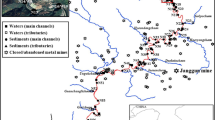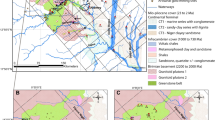Abstract
Previous studies found elevated metal concentrations in Manadas Creek. In this study, samples were collected from six sites along the creek during the wet period of 2008 and analyzed for dissolved and total metal isotopes in water and total metal isotopes in sediments. Results were compared with those obtained in a dry period. It was found that 75As concentration in water was typically the lowest following a major rain event. A similar trend was observed for antimony (Sb) at the two sites, close to a decommissioned Sb smelter. Mann-Whitney test indicates significant differences in the medians of 75As concentrations observed in the sediment between the dry and the wet seasons at most sites and for 121Sb at two sites sampled. The enrichment factors (EFs) calculated for As in sediment were low (close to 1); however, they were up to 1,530.9 and 1,519.1 for 121Sb and 123Sb, respectively. Cluster analysis grouped 75As with 208Pb, 118Sn, 66Zn, and 137Ba, or with 55Mn, or with 60Ni depending on the sites sampled; however, both Sb isotopes were not grouped with any other metals. Pearson correlation only indicated significant and strong correlation between 75As and sediment properties. Significant correlation between 75As and other metals was only found at one site. Most of the correlations between 121Sb/123Sb and other metals were poor. These results contribute to the understanding of the seasonal variations of Sb and As contamination in a semi-arid creek.
Access this chapter
Tax calculation will be finalised at checkout
Purchases are for personal use only
Similar content being viewed by others
References
Adriano, D. (2001). Trace elements in terrestrial environments: Biogeochemistry, bioavailability and risks of metals (2nd ed.). New York: Springer.
Baeza, M., Ren, J., Krishnamurthy, S., & Vaughan, T. (2010). Spatial distribution of antimony and arsenic levels in Manadas Creek, an urban tributary of the Rio Grande in Laredo, Texas. Archives of Environmental Contamination and Toxicology, 58(2), 299–314. doi:10.1007/s00244-009-9357-0.
Ben-Othman, D., Luck, J., & Tournoud, M. (1997). Geochemistry and water dynamics: Application to short time scale flood phenomena in a small Mediterranean catchment. Chemical Geology, 140, 9–28.
Bertine, K., Walawender, S., & Koide, M. (1978). Chronological strategies and metal fluxes in semi-arid lake sediments. Geochimica et Cosmochimica Acta, 42, 1559–1571.
Brady, N. (1984). The nature and properties of soils. New York: MacMillan.
Brezonik, L., & Stadelmann, H. (2002). Analysis and predictive models of storm water runoff volume, loads, and pollutant concentrations from watersheds in the Twin Cities metropolitan area, Minnesota, USA. Water Research, 36, 1743–1757.
Chopin, E., Black, S., Hodson, M., Coleman, M., & Alloway, B. (2003). A preliminary investigation into mining and smelting impacts on trace element concentrations in the soils and vegetation around Tharsis, SW Spain. Mineralogical Magazine, 67, 279–288.
Dean, W., & Dean, W. (1974). Determinations of carbonate and organic matter in calcareous sediments and sedimentary rocks by loss on ignition: Comparison with other methods. Journal of Sedimentary Petrology, 44(1), 242–248.
Ellis, J. (1986). Pollution aspects of urban runoff. In H. C. Trono, J. Marsalek, & M. Desbordes (Eds.), Urban runoff pollution NATO ADI series (pp. 1–38). New York: Springer.
Flores, B. (2007). Chemical contamination of the lower Rio Grande near Laredo, TX. Unpublished master’s thesis, Texas A&M University-Kingsville, Kingsville, TX.
Graf, W., Clark, S., Kammerer, M., Lehman, T., Randall, K., & Schroeder, S. (1991). Geomorphology of heavy metals in the sediments of Queen Creek, Arizona, USA. Catena, 18(6), 567–582.
Iavazzo, P., Ducci, D., Adamo, P., et al. (2012). Impact of past mining activity on the quality of water and soil in the high Moulouya Valley (Morocco). Water, Air, and Soil Pollution, 223(2), 573–589. doi:10.1007/s11270-011-0883-9.
Kim, C. S., Stack, D. H., & Rytuba, J. J. (2012). Fluvial transport and surface enrichment of arsenic in semi-arid mining regions: Examples from the Mojave Desert, California. Journal of Environmental Monitoring, 14(7), 1798–1813. doi:10.1039/c2em30135k.
Navarro, M., Perez-Sirvent, C., Martinez-Sanchez, M., Vidal, J., Tovar, P., & Bech, J. (2008). Abandoned mine sites as a source of contamination by heavy metals: A case study in a semi-arid zone. Journal of Geochemical Exploration, 96, 183–193.
Querol, X., Alastuey, A., López-Soler, A., & Plana, F. (2000). Levels and chemistry of atmospheric particulates induced by a spill of heavy metal mining wastes in the Doñana area, Southwest Spain. Atmospheric Environment, 34, 239–253.
Rappole, J. H., Russell, C. E., Norwine, J. R., & Fulbright, T. E. (1986). Anthropogenic pressures and impacts on marginal, neotropical, semiarid ecosystems: The case of South Texas. Science of the Total Environment, 55, 91–99.
Razo, I., Carrizales, L., Castro, J., Díaz Barriga, F., & Monroy, M. (2004). Arsenic and heavy metal pollution of soil, water and sediments in a semi-arid climate mining area in Mexico. Water, Air, and Soil Pollution, 152, 129–152.
Silveira, M., Alleoni, L., O’Connor, G., & Chang, A. (2006). Heavy metal sequential extraction methods: A modification for tropical soils. Chemosphere, 64, 1929–1938.
Texas Commission on Environmental Quality [TCEQ]. (2003). Surface water quality monitoring procedures: Vol. 1: Physical and chemical monitoring methods for water, sediment and tissue. Austin, TX: Texas Commission on Environmental Quality.
Texas Natural Resource Conservation Commission [TNRCC]. (1997). Second phase of the binational study regarding the presence of toxic substances in the Rio Grande/Rio Bravo and its tributaries along the boundary portion between the United States and Mexico (Final report). Austin, TX: Texas Natural Resource Conservation Commission.
TNRCC. (2002). State of the Rio Grande and the environment of the border region, strategic plan (Fiscal years 2003–2007, Vol. 3). Austin, TX: Texas Natural Resource Conservation Commission.
United States Environmental Protection Agency [U.S.EPA]. (1994). Method 200.8, determination of trace elements in waters and wastes by inductively coupled plasma–mass spectrometry. Cincinnati, OH: Environmental Monitoring Systems Laboratory, Office of Research and Development.
United States Environmental Protection Agency [U.S.EPA]. (1997). Damage cases and environmental releases from mines and mineral processing sites. Washington, DC: Offices of Solid Waste, U.S.EPA.
United States Environmental Protection Agency [U.S.EPA]. (2005). Guidance for develo** ecological soil screening levels. Washington, DC: Office of Solid Waste and Emergency Response.
United States Environmental Protection Agency [U.S.EPA]. (2007). Microwave assisted acid digestion of sediments, sludge, soils and oils. Washington, DC: U.S.EPA.
United States Section, International Boundary and Water Commission [U.S.IBWC]. (1994). Binational study regarding the presence of toxic substances in the Rio Grande/Rio Bravo and its tributaries along the boundary portion between the United States and Mexico. El Paso, TX: International Boundary and Water Commission.
Van Geen, A., Takesue, R., & Chase, Z. (1999). Acid mine tailings in southern Spain. The Science of the Total Environment, 242, 221–229.
Vaze, J., & Chiew, F. (2002). Experimental study of pollutant accumulation on an urban road surface. Urban Water, 4, 379–389.
Wulf, H., Bookhagen, B., & Scherler, D. (2012). Climatic and geologic controls on suspended sediment flux in the Sutlej River Valley, western Himalaya. Hydrology and Earth System Sciences, 16(7), 2193–2217. doi:10.5194/hess-16-2193-2012.
Acknowledgements
This article was based upon work supported by the Center of Research Excellence in Science and Technology–Research on Environmental Sustainability of Semi-Arid Coastal Areas (CREST–RESSACA) at Texas A&M University-Kingsville (TAMUK) through a Cooperative Agreement (HRD-0734850) from the National Science Foundation (NSF). It was also supported by a TAMUK Graduate Assistantship and Scholarship from The National Council on Science and Technology (CONACYT) of Mexico to M. Baeza. Any opinions, findings, and conclusions or recommendations expressed in this material are those of the authors and do not necessarily reflect the views of the National Science Foundation or the National Council on Science and Technology of Mexico. We would like to thank Andrew G. Smith for reviewing the manuscript before submission.
Author information
Authors and Affiliations
Corresponding author
Editor information
Editors and Affiliations
Rights and permissions
Copyright information
© 2014 Springer Science+Business Media Dordrecht
About this chapter
Cite this chapter
Baeza, M., Ren, J., Krishnamurthy, S., Vaughan, T.C. (2014). Antimony and Arsenic Isotope Distribution in a Semi-Arid Creek During the Wet Season. In: Ramirez, D., Ren, J., Jones, K., Lamm, H. (eds) Environmental Sustainability Issues in the South Texas–Mexico Border Region. Springer, Dordrecht. https://doi.org/10.1007/978-94-007-7122-2_8
Download citation
DOI: https://doi.org/10.1007/978-94-007-7122-2_8
Published:
Publisher Name: Springer, Dordrecht
Print ISBN: 978-94-007-7121-5
Online ISBN: 978-94-007-7122-2
eBook Packages: Earth and Environmental ScienceEarth and Environmental Science (R0)




